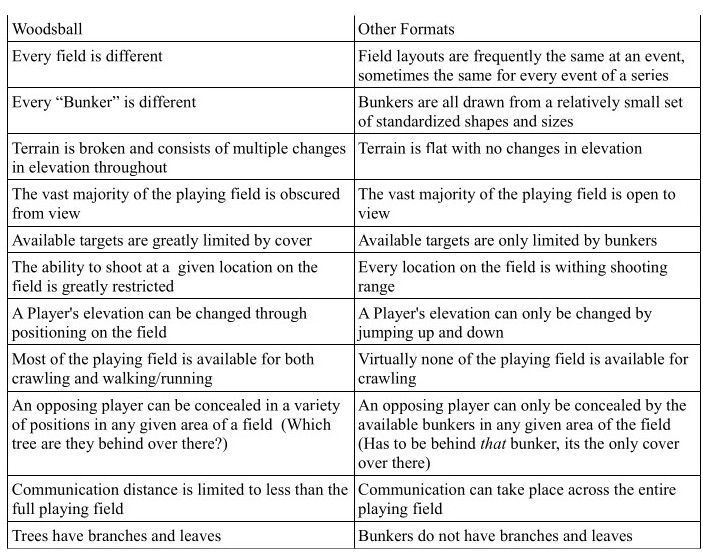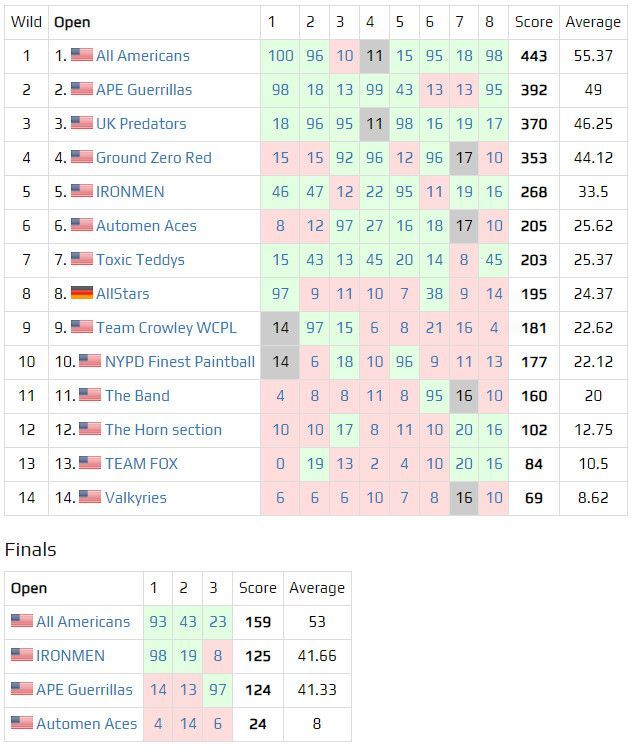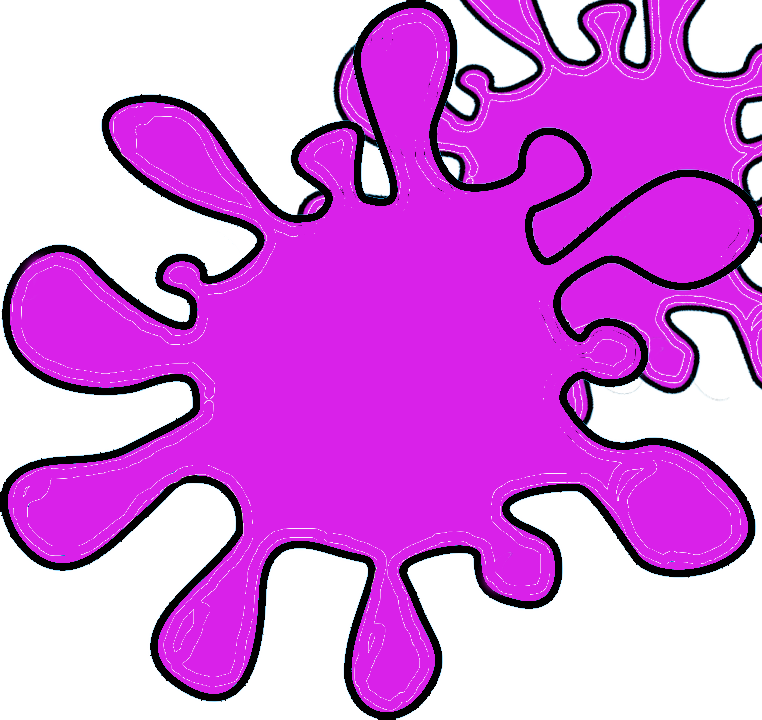Woodsball Requires the Use of a Wider Range of Skills Than Most Other Formats (Part 1)
(A caveat: Since many scenario and big games are also played in the woods, not all of the differences noted here apply to those game formats.)
I've been struggling for a while to find the correct way to address the differences, and have previously gone to some pains to explain that this article is not about declaring one format better than another. (See my Facebook post on the WCPL page). Rather, its purpose is to explore those differences in an objective manner so that players, particularly those new to the sport, can decide where and how to play based on understanding the real differences.
During its evolution, the primary and popular forms of paintball have shifted numerous times. This has as much to do with marketing, economics and influencers (not to mention sponsors, geography and other factors) as it does with learning about the game and changing things to make it a better sport.
The first version of this game was “every player for themselves”. That morphed into 15 player ball on multi-acre woods fields to scenario games, to ten player woodsball, five player arena/speedball, to artificial terrain and to high-speed, multiple-scoring events on comparatively tiny fields.
During most of that evolution, the skill set required for players who wanted to play well did not change. Players needed to be able to move (preferably quickly), they needed to have decent accuracy with their shooting, they needed to know how to move and conceal themselves in the woods, they needed to have a sense of timing, some tactical ability, some strategic ability, some familiarity with logistics. They needed to be able to “read the lay of the land”, be able to communicate meaningfully, to be able to psychologically assess their opponents, to adjust quickly to changing situations and to manage all of those skills effectively – while hiding behind inadequate cover as a rain of paintballs assaulted them.
Before getting to the differences, I want to explain all of those skills in a bit more detail.
Movement:
Successful players are good, broken-field runners. They are also good sneaky-petes, able to silently move through the woods (quickly if need be) without crinkling leaves under foot or making brush sway. They need to be able to crawl (often blindly), and to move from one mode to another almost effortlessly. Fast is usually better than slow, but lack of speed can be compensated for with better positioning, better angles, better field craft.
Shooting: Well, it's a gun game, right? If you can't shoot accurately over distance you're nothing but a target (which can be a skill all by itself, btw). But we're not talking the ability to shoot ropes at targets 150 feet away; we're talking about being able to find a hole between branches and leaves that follows a ballistic (curved) path between shooter and target, when the opening to that “tunnel” starts 50 feet away from the shooter. We're talking about being able to shoot accurately while lying on your back, or running over tree roots, being able to drop balls on a target like mortar shells. There is a fundamental difference in the shooting skill set when every potential target on the field is within shooting range. (A woodsball field is typically more than a thousand feet long and 500+ feet wide. You can't shoot tape to tape like you can on many current tournament fields.) And shooting “long-ball” (pointing your barrel up into the air and arcing balls for maximum range) has almost become a lost art. You can do it, effectively, but it takes a lot of practice.
Concealment: Here's the thing. Trees and brush are not Doritos and Cans. Flat grass fields are not broken ground covered with roots and vines or ankle-breaking holes. Once you learn how to play a Dorito, or a Temple or a Can, every Dorito plays the same (unless it's deflating or has become unmoored). Not so for trees. Every single tree in the woods is different and plays differently. Even when they are of the same species: they may play similarly, but not the same. When you walk a field with artificial terrain, half the job has already been done for you, because your cover will always be one of a handful of known shapes. When you walk a woodsball field, you need to individually evaluate the suitability of each piece of cover within a given location. There might be a “perfect” tree in the best location for that spot on the field, but in evaluating it, you discover that low branches will prevent you from using it as an effective position.
Timing: We're not talking the game length here. We're talking about knowing how long it takes a player to get from point A to point B; how the terrain affects that movement (there are fast areas – like paths, and slow areas, like swamp or marsh). What the absolute minimum time to run a flag back is – on that particular field (it will be different for each and every other field). How long it will take a player to crawl through brush. How long it will take for an opponent to move between two locations, and whether or not you can reach an alternate position in the same or less time. It's one thing to run a field with flat ground and minimal obstacles, another to run through the woods, on broken ground, with a literal infinitude of possible paths.
Logistics, Strategy, Tactics: Logistics is what gets you to the paintball event, makes sure you've got enough paint in every player's pods, gets folks on line for air so they've got full tanks before every game; it's what puts the right tools for your gear in the team tool box. Strategy is where you evaluate the entire event; your series of opponents, when you'll play them, where you'll play them. Knowing that a future opponent will be able to watch how you play a particular field and knowing that maybe you want to show them a slightly different plan from how you intend to play them. Tactics is the down and dirty individual play. Determining that one player can reach a particular location on the field while another can not, and arranging positions accordingly. Deciding that you need two players to hold a particular location and so on. These three elements are similar for all forms of play, but they're more complicated in woodsball, because of all of the infinite number of other factors.
Communication: I only need point out that visual communication is almost impossible on a woodsball field and that shouting something that can be heard 1,200 feet away takes a lot more effort than shouting something that can be heard 150 feet away. But good players adapt and learn. Most experienced woodsball players have learned to tell what is happening on the field by HOW their teammates are shooting. Try doing that on a field that seems designed to maximize noise, while twenty players are all shooting at 10 plus BPS. (I've not even mentioned codes, or disinformation campaigns.)
Psychology: Psyching the opposing team out is one thing. Figuring out how an opposing team is going to handle a particular situation by watching them and getting inside their heads is another. Not to mention playing “mind games” while on the field. Most contemporary game formats don't offer enough time or separation between players to let this other element of the game express itself fully, but in woodsball, it is entirely possible to do things like getting the other team to forget your presence on the field, make them believe that there are more players from your team alive, on the field, than there are, or to convince them that there are fewer players in a given location than there really are. If you can get inside the “mental curve” of your opponents, a whole new tool set opens up for you.
Each of those skills is present and required in just about every paintball format. But there are two primary differences between woodsball and other formats and applying those skills during a game. The first is the far greater number of variables found in the woods that complicate the execution of those skills. The other is that woodsball players can not be specialists.
Each player on a woodsball team has to be able to execute each and every one of those skills effectively, because at any given time, they might have to play offensively or defensively; they might have to run to cover a hole, or crawl to get a dominating position; they might have to play the tape, or the middle of the field, from down in a ditch or from the top of a hill. Each player might have a skill that they are better at than their teammates, and good teams utilize those players appropriately at the beginning of a game, but in general, every woodsball player has to be able to effectively execute those skills no matter where they are on the field and at any given time during the game. The differrence between woodsball skill sets and other format skill sets might be described as the following: woodball players are generalists with specialty skills, players in other formats are specialists with some general skills. (At this point, you might want to look up evolutionary theory and see what it has to say about specialization. The gist of it is that specialization makes a species successful in its given environment, but that it lacks the ability to adapt to other environments.)
By way of further illustration: a back player in arena games specializes on providing cover, reading the field and filling in forward positions at the appropriate time. A snake player specializes in getting to and into the snake, dealing with opposing snake players in close quarters and shooting cross-field. If, at the beginning of a game you were to swap those two players...well, that game probably won't go as well as it might have with players in their accustomed positions.
In woodsball, it is fairly common for players to be positioned anywhere on the field, based on the needs of that particular field and opponents. About the only specialized positions there are to be found on a woodsball team are the field captain and, maybe, a tape player or two (players up against the field boundaries).
Again, one approach is not “better” than the others. But I do contend that woodball players have (and need to have) a grounding in a wider range of skills than that which is required for other competitive forms of the game. And this makes sense if you approach things from a requirements and training point of view. No coach in their right mind would waste valuable teaching and training time on, say, training their players how to swim long distances, as there is no playing scenario in which such a skill would be necessary. Training a snake player how to snap shoot, how to gauge where opponents are from where paint is hitting, how to slide, crawl, etc. absolutely. Maybe even on training designed to make them comfortable with lying in a mud puddle, but not long distance swimming. Nor would they waste time and money teach their team how to knit – unless everyone on the team was keen on wearing custom knitted beanies.
As a wise old baller who wrote under the nom-de-guerre of The Ultimate Warrior once stated, you train like you play and you play like you train. To which I would add – and your training should be under a harder and more difficult regimen than whatever might be required for play. (Use crappy paint, bunkers that are smaller than typical, run uphill, both ways, face greater number of opponents, etc.)
Perhaps belaboring the point, here are some key differences arranged in a list:

What the preceding table and text are attempting to illustrate can be summed up by paraphrasing President Kennedy's famous space race speech at Rice University: “We play this game not because it is easy, but because it is hard.”
I will hasten to add that the “hard” referenced here also translates into “fun” and “greater variety of play”.
When your tool box is loaded with additional skills, the ways in which you can play, effectively, increase exponentially. You can't win an arena ball game by throwing a rock into a bush. You might be able to win a woodsball game that way (and I have). This is because the options available to a woodsball player, on the field, are not restricted to only moving, shooting and communicating.
In Part Two, we'll get into the weeds on actual play in the woods.








